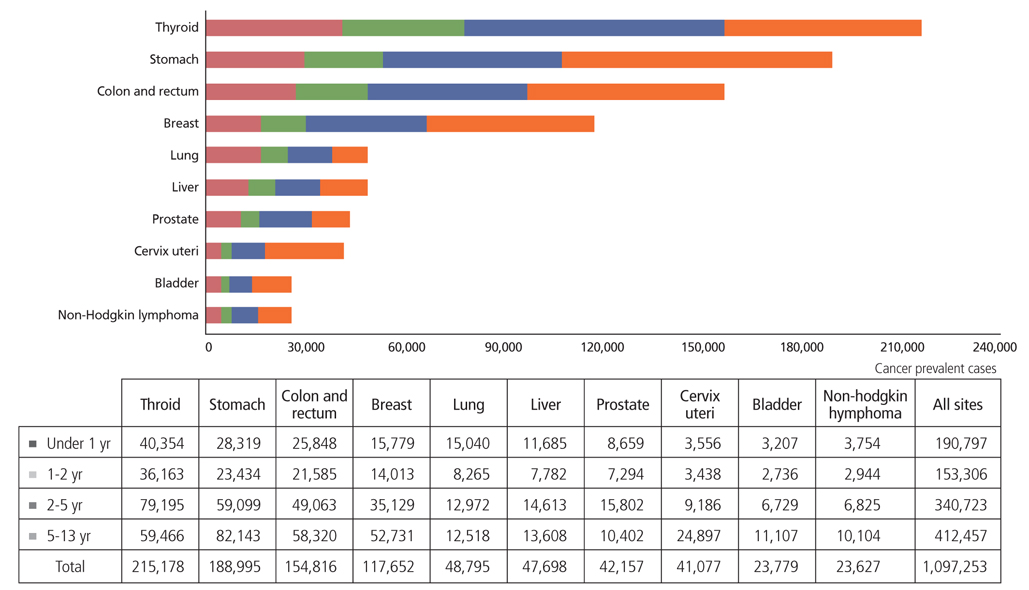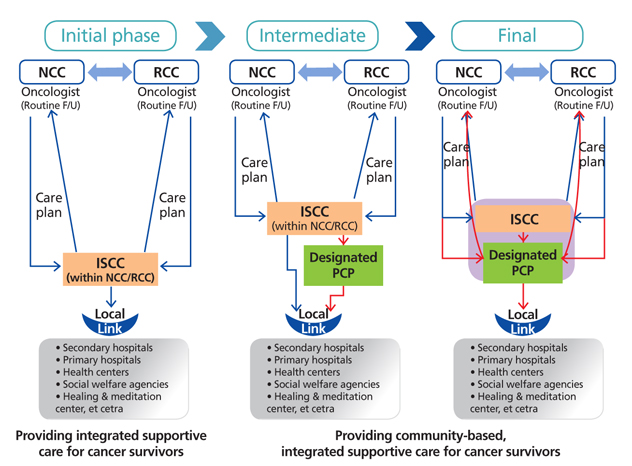J Korean Med Assoc.
2015 Mar;58(3):216-226. 10.5124/jkma.2015.58.3.216.
Management of cancer survivors in Korea
- Affiliations
-
- 1Cancer Survivorship Clinic, Department of Family Medicine, Seoul National University Hospital, Seoul National University College of Medicine, Seoul, Korea.
- 2Cancer Prevention Clinic, Department of Family Medicine, Asan Medical Center, University of Ulsan College of Medicine, Seoul, Korea.
- 3Supportive Care Center, Department of Family Medicine, Samsung Medical Center, Sungkyunkwan University College of Medicine, Seoul, Korea. jklee@skku.edu
- KMID: 2194942
- DOI: http://doi.org/10.5124/jkma.2015.58.3.216
Abstract
- With the early detection of cancer and advances in cancer treatment, the number of cancer survivors is increasing dramatically and is currently over 1 million. Many cancer survivors face lifetime risks associated with their cancer therapy, with a significant proportion at risk for serious morbidity and premature mortality. The long-term physical and psychosocial effects of cancer treatment on cancer survivors and their families are increasingly being recognized as emerging problems from both clinical and public health perspectives. This article summarizes the core principles of management of cancer survivors: follow-up of primary cancer; screening and prevention of a second primary cancer; management of late effects of cancer treatment and comorbid conditions; promotion of healthy behaviors such as smoking cessation, exercise and physical activity, nutrition, and weight management; management of psychosocial problems; and support for family caregivers. Finally, we discuss the way forward for improving survivorship care: shared care between oncologists and primary care physicians; a comprehensive cancer support program; and further research to generate relevant evidence regarding these management principles.
Keyword
MeSH Terms
Figure
Cited by 3 articles
-
Management of long-term cancer survivors in primary care
Dong Wook Shin, Jungkwon Lee
J Korean Med Assoc. 2016;59(4):252-255. doi: 10.5124/jkma.2016.59.4.252.Management of long-term gastric cancer survivors in Korea
Dong Wook Shin, Seung Hyun Yoo, Sung Sunwoo, Moon-Won Yoo
J Korean Med Assoc. 2016;59(4):256-265. doi: 10.5124/jkma.2016.59.4.256.Risky Lifestyle Behaviors among Gastric Cancer Survivors Compared with Matched Non-cancer Controls: Results from Baseline Result of Community Based Cohort Study
Minkyung Kim, Kui Son Choi, Mina Suh, Jae Kwan Jun, Kumban Walter Chuck, Boyoung Park
Cancer Res Treat. 2018;50(3):738-747. doi: 10.4143/crt.2017.129.
Reference
-
1. Jung KW, Won YJ, Kong HJ, Oh CM, Lee DH, Lee JS. Cancer statistics in Korea: incidence, mortality, survival, and prevalence in 2011. Cancer Res Treat. 2014; 46:109–123.
Article2. Mullan F. Seasons of survival: reflections of a physician with cancer. N Engl J Med. 1985; 313:270–273.
Article3. Hewitt ME, Greenfield S, Stovall E. From cancer patient to cancer survivor: lost in transition. Washington, DC: National Academies Press;2006.4. Yang HK. Information Committee of the Korean Gastric Cancer Association. Current status of clinical practice for gastric cancer patients in Korea: a nationwide survey. J Korean Gastric Cancer Assoc. 2004; 4:95–108.
Article5. Grunfeld E, Levine MN, Julian JA, Coyle D, Szechtman B, Mirsky D, Verma S, Dent S, Sawka C, Pritchard KI, Ginsburg D, Wood M, Whelan T. Randomized trial of long-term follow-up for early-stage breast cancer: a comparison of family physician versus specialist care. J Clin Oncol. 2006; 24:848–855.
Article6. Curtis RE, Freedman DM, Ron E, Ries LAG, Hacker DG, Edwards BK, Tucker MA, Fraumeni JF Jr. New malignancies among cancer survivors: SEER cancer registries, 1973-2000. Bethesda: National Cancer Institute;2006.7. Dong C, Hemminki K. Second primary neoplasms in 633,964 cancer patients in Sweden, 1958-1996. Int J Cancer. 2001; 93:155–161.
Article8. Tabuchi T, Ito Y, Ioka A, Miyashiro I, Tsukuma H. Incidence of metachronous second primary cancers in Osaka, Japan: update of analyses using population-based cancer registry data. Cancer Sci. 2012; 103:1111–1120.
Article9. Nielsen SF, Nordestgaard BG, Bojesen SE. Associations between first and second primary cancers: a population-based study. CMAJ. 2012; 184:E57–E69.
Article10. Shin DW, Cho B, Kim SY, Jung JH, Park JH. Management of cancer survivors in clinical and public health perspectives: current status and future challenges in Korea. J Korean Med Sci. 2013; 28:651–657.
Article11. Schaapveld M, Visser O, Louwman MJ, de Vries EG, Willemse PH, Otter R, van der Graaf WT, Coebergh JW, van Leeuwen FE. Risk of new primary nonbreast cancers after breast cancer treatment: a Dutch population-based study. J Clin Oncol. 2008; 26:1239–1246.
Article12. Shin DW, Kim YW, Oh JH, Kim SW, Chung KW, Lee WY, Lee JE, Lee WC, Guallar E, Cho J. Knowledge, attitudes, risk perception, and cancer screening behaviors among cancer survivors. Cancer. 2011; 117:3850–3859.
Article13. Shin DW, Baik YJ, Kim YW, Oh JH, Chung KW, Kim SW, Lee WC, Yun YH, Cho J. Knowledge, attitudes, and practice on second primary cancer screening among cancer survivors: a qualitative study. Patient Educ Couns. 2011; 85:74–78.
Article14. Shin DW, Kim Y, Baek YJ, Mo HN, Choi JY, Cho J. Oncologists experience with second primary cancer screening: current practices and barriers and potential solutions. Asian Pac J Cancer Prev. 2012; 13:671–676.
Article15. Shin DW, Cho J, Kim YW, Oh JH, Kim SW, Chung KW, Lee WY, Lee JE, Guallar E, Lee WC. Efficacy of an educational material on second primary cancer screening practice for cancer survivors: a randomized controlled trial. PLoS One. 2012; 7:e33238.
Article16. Earle CC, Neville BA. Under use of necessary care among cancer survivors. Cancer. 2004; 101:1712–1719.
Article17. Shin DW, Park JH, Park JH, Park EC, Kim SY, Kim SG, Choi JY. Antihypertensive medication adherence in cancer survivors and its affecting factors: results of a Korean population-based study. Support Care Cancer. 2010; 19:211–220.
Article18. Shin JY, Shim HY, Jun JK. Comparison of diabetes management status between cancer survivors and the general population: results from a Korean population-based survey. PLoS One. 2014; 9:e110412.
Article19. Shin DW, Kim Y, Park JH, Cho J, Jho HJ, Yang HK, Kim HS, Kim SY. Practices and predictors of 2009 H1N1 vaccination in cancer patients: a nationwide survey in Korea. Influenza Other Respir Viruses. 2012; 6:e120–e128.
Article20. Shin DW, Ahn E, Kim H, Park S, Kim YA, Yun YH. Non-cancer mortality among long-term survivors of adult cancer in Korea: national cancer registry study. Cancer Causes Control. 2010; 21:919–929.
Article21. Yang HK, Shin DW, Park JH, Kim SY, Eom CS, Kam S, Choi JH, Cho BL, Seo HG. The association between perceived social support and continued smoking in cancer survivors. Jpn J Clin Oncol. 2013; 43:45–54.
Article22. Shin DW, Park JH, Kim SY, Park EW, Yang HK, Ahn E, Park SM, Lee YJ, Lim MC, Seo HG. Guilt, censure, and concealment of active smoking status among cancer patients and family members after diagnosis: a nationwide study. Psychooncology. 2014; 23:585–591.
Article23. Daling JR, Malone KE, Doody DR, Johnson LG, Gralow JR, Porter PL. Relation of body mass index to tumor markers and survival among young women with invasive ductal breast carcinoma. Cancer. 2001; 92:720–729.
Article24. Kroenke CH, Chen WY, Rosner B, Holmes MD. Weight, weight gain, and survival after breast cancer diagnosis. J Clin Oncol. 2005; 23:1370–1378.
Article25. Druesne-Pecollo N, Touvier M, Barrandon E, Chan DS, Norat T, Zelek L, Hercberg S, Latino-Martel P. Excess body weight and second primary cancer risk after breast cancer: a systematic review and meta-analysis of prospective studies. Breast Cancer Res Treat. 2012; 135:647–654.
Article26. Chlebowski RT, Blackburn GL, Thomson CA, Nixon DW, Shapiro A, Hoy MK, Goodman MT, Giuliano AE, Karanja N, McAndrew P, Hudis C, Butler J, Merkel D, Kristal A, Caan B, Michaelson R, Vinciguerra V, Del Prete S, Winkler M, Hall R, Simon M, Winters BL, Elashoff RM. Dietary fat reduction and breast cancer outcome: interim efficacy results from the Women's Intervention Nutrition Study. J Natl Cancer Inst. 2006; 98:1767–1776.
Article27. Meyerhardt JA, Giovannucci EL, Holmes MD, Chan AT, Chan JA, Colditz GA, Fuchs CS. Physical activity and survival after colorectal cancer diagnosis. J Clin Oncol. 2006; 24:3527–3534.
Article28. Schmitz KH, Courneya KS, Matthews C, Demark-Wahnefried W, Galvao DA, Pinto BM, Irwin ML, Wolin KY, Segal RJ, Lucia A, Schneider CM, von Gruenigen VE, Schwartz AL. American College of Sports Medicine. American College of Sports Medicine roundtable on exercise guidelines for cancer survivors. Med Sci Sports Exerc. 2010; 42:1409–1426.
Article29. Ahn E, Shin DW, Cho SI, Park S, Won YJ, Yun YH. Suicide rates and risk factors among Korean cancer patients, 1993-2005. Cancer Epidemiol Biomarkers Prev. 2010; 19:2097–2105.
Article30. Shin DW, Kim SY, Cho J, Sanson-Fisher RW, Guallar E, Chai GY, Kim HS, Park BR, Park EC, Park JH. Discordance in perceived needs between patients and physicians in oncology practice: a nationwide survey in Korea. J Clin Oncol. 2011; 29:4424–4429.
Article31. National Cancer Center. Recommendations for distress management in cancer patients. Goyang: National Cancer Center;2009.32. Eom CS, Shin DW, Kim SY, Yang HK, Jo HS, Kweon SS, Kang YS, Kim JH, Cho BL, Park JH. Impact of perceived social support on the mental health and health-related quality of life in cancer patients: results from a nationwide, multicenter survey in South Korea. Psychooncology. 2013; 22:1283–1290.
Article33. Cho J, Smith K, Choi EK, Kim IR, Chang YJ, Park HY, Guallar E, Shim YM. Public attitudes toward cancer and cancer patients: a national survey in Korea. Psychooncology. 2013; 22:605–613.
Article34. Park JH, Park EC, Park JH, Kim SG, Lee SY. Job loss and re-employment of cancer patients in Korean employees: a nationwide retrospective cohort study. J Clin Oncol. 2008; 26:1302–1309.
Article35. Oeffinger KC, McCabe MS. Models for delivering survivorship care. J Clin Oncol. 2006; 24:5117–5124.
Article36. Cheung WY, Neville BA, Cameron DB, Cook EF, Earle CC. Comparisons of patient and physician expectations for cancer survivorship care. J Clin Oncol. 2009; 27:2489–2495.
Article37. Mao JJ, Bowman MA, Stricker CT, DeMichele A, Jacobs L, Chan D, Armstrong K. Delivery of survivorship care by primary care physicians: the perspective of breast cancer patients. J Clin Oncol. 2009; 27:933–938.
Article38. Park JH, Shin DW. The era of one million cancer survivors, healthcare for the cancer survivors. Health Policy Forum. 2012; 10:[Epub]. http://webzine.rihp.re.kr/webzine_201302/w_07_03.html.39. Shin DW, Park JH. Long-term survivorship clinics led by primary care physicians within the cancer center may be a good option for coordinated survivorship care. Cancer. 2014; 120:3752–3753.
Article40. Seo HG, Park JH. Evidence-based cancer survivorship management. Goyang: National Cancer Center;2013.
- Full Text Links
- Actions
-
Cited
- CITED
-
- Close
- Share
- Similar articles
-
- Cancer Survivorship Care and Roles of Oncology Nurses
- Experiences of Self-management Support among Breast Cancer Survivors
- Healthcare Professionals’ Experience of Fear of Cancer Recurrence among Cancer Survivors
- Management of breast cancer survivors in gynecologic area
- Public Attitudes towards Cancer Survivors among Korean Adults





